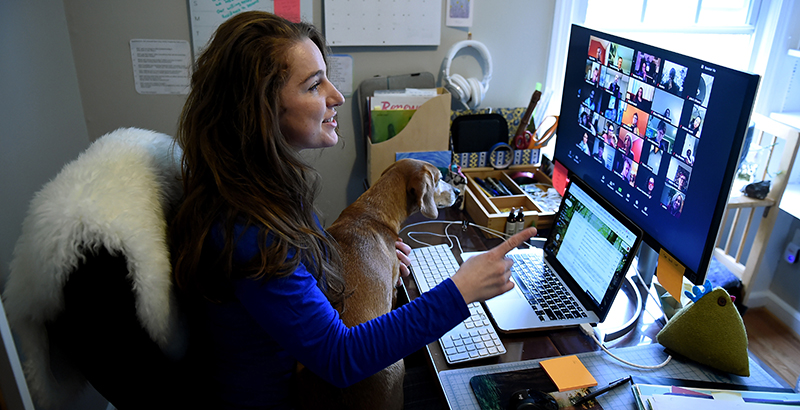Jerabek: Teacher-Student Connections Get Lost in Distance Learning. We Must Start Rebuilding Those Relationships When School Reopens

As the year ends on a note no one expected, amid the confusion and uncertainty about our forced nationwide experiment with online schooling, there are a couple things we can be sure about. First, distance learning is challenging for both students and teachers. Second, even when it goes well, teachers and students still struggle with the loss of in-person connections.
As the nation’s teachers and students adjust to this new reality, these conclusions may seem like bad news, but the opposite is actually true. I’m an incurable optimist but also a determined realist; that comes from being a high school counselor.
Let me explain.
Distance learning has solidified what we already knew: Schools are not just educational spaces but critical social and emotional learning communities. Schools do so much more than help students grow academically. They enable adults and students to connect and grow.
Relationships matter immensely.
Teachers provide students with intangible gifts that influence their lives. Teachers can turn students’ discouragement into resolution and their fears into triumphs. They see the infinite potential of each child. But it is far easier to see it when you can actually “see it.”
Students also provide such intangible gifts to teachers. We go to work every day to engage with students; that is what we signed up to do — engage. We thrive when we help them navigate not just academic learning but also how to deal with themselves and others, how to behave in groups, how to take responsibility, how to be empathetic and how to deal with self-doubt, fear, anger, uncertainty and a range of other emotions and feelings. Their successes are our accomplishments.
“I miss the kids’ laughter,” Sue Brown, a veteran teacher in California, told me. “I miss spring when students are asking each other to prom, I miss chaperoning dances, going to students’ baseball games, track meets, plays, concerts and graduations to see them succeed and celebrate with their families.”
Teachers are the strongest and most creative people I know. Their commitment to their students has been exemplified by their ability to move to new learning platforms with almost no warning and minimal training. But teachers have always done more than teach. They listen, advise, cajole, advocate, cheerlead and celebrate.
Schools are about both head and heart. While the head aspects are being mostly addressed these days through academic assignments done via take-home packets, Zoom meetings and Google classrooms, the heart part, the relationships, are suffering. On a systems level, the fact that teachers are frustrated by the absence of physical relationships is actually a positive sign that we are collectively remembering how critical real relationships are. While a teacher may share a look with a student on Zoom or interact with students using a chat function in Google Classroom, it’s nothing like the energy that comes from being together in a physical space.
Education is a profession that is predicated on caring about others. Relationships are the heartbeat of the classroom. Teaching is about creating connections so students feel safe and secure and are able to participate in academics. As a society, it is affirming to know that we need to be in relationships. So, of course, educators don’t feel right — it’s difficult to connect with people when we only see them on a screen.
Listen to Erik Ahlquist, an advanced math teacher who has taught for 25 years in Minnesota: “Not being in class is so removed. It feels like I am just doing checks about assignments and grades. Making videos about a lesson does not bring a spark. I can’t really see the reactions of the students and whether they understand the math. I miss laughing with them. I miss counseling them when they need help with life in general. A teacher like me who loves his job does so because of the relationships they build with students. Without that, it is very dry and dull.”
We are in a reactive mode right now. What we are learning is a reminder that, as we shift into rebuilding mode, we must keep connections at the center. We must remember the centrality of relationships in pursuit of learning and growing up.
When we go back to school physically, we obviously will need to address students’ many differentiated academic needs. We will need to provide wraparound supports including mental health services. Students will need the safety net that schools provide in order to recover.
At the same time, there will be a need for us to focus on social and emotional learning, because education isn’t a series of online transactions but the kind of connections and relationships that grow when we spend time together.
School is at the center of children’s lives. It’s the place where they learn to live alongside one another. No matter how creative their teachers are, they won’t learn that online.
That’s why, teachers, feeling bad is good. It reaffirms what we already know to be true: Relationships are critical, and when we get back together, we need to start there.
Angela Jerabek began her career in education as a licensed K-12 teacher and secondary school counselor. Now, Angela serves as the founder and executive director of the BARR Center (Building Assets, Reducing Risks), a national school improvement network based in Minneapolis that is delivering positive results across the United States.
Get stories like these delivered straight to your inbox. Sign up for The 74 Newsletter

;)